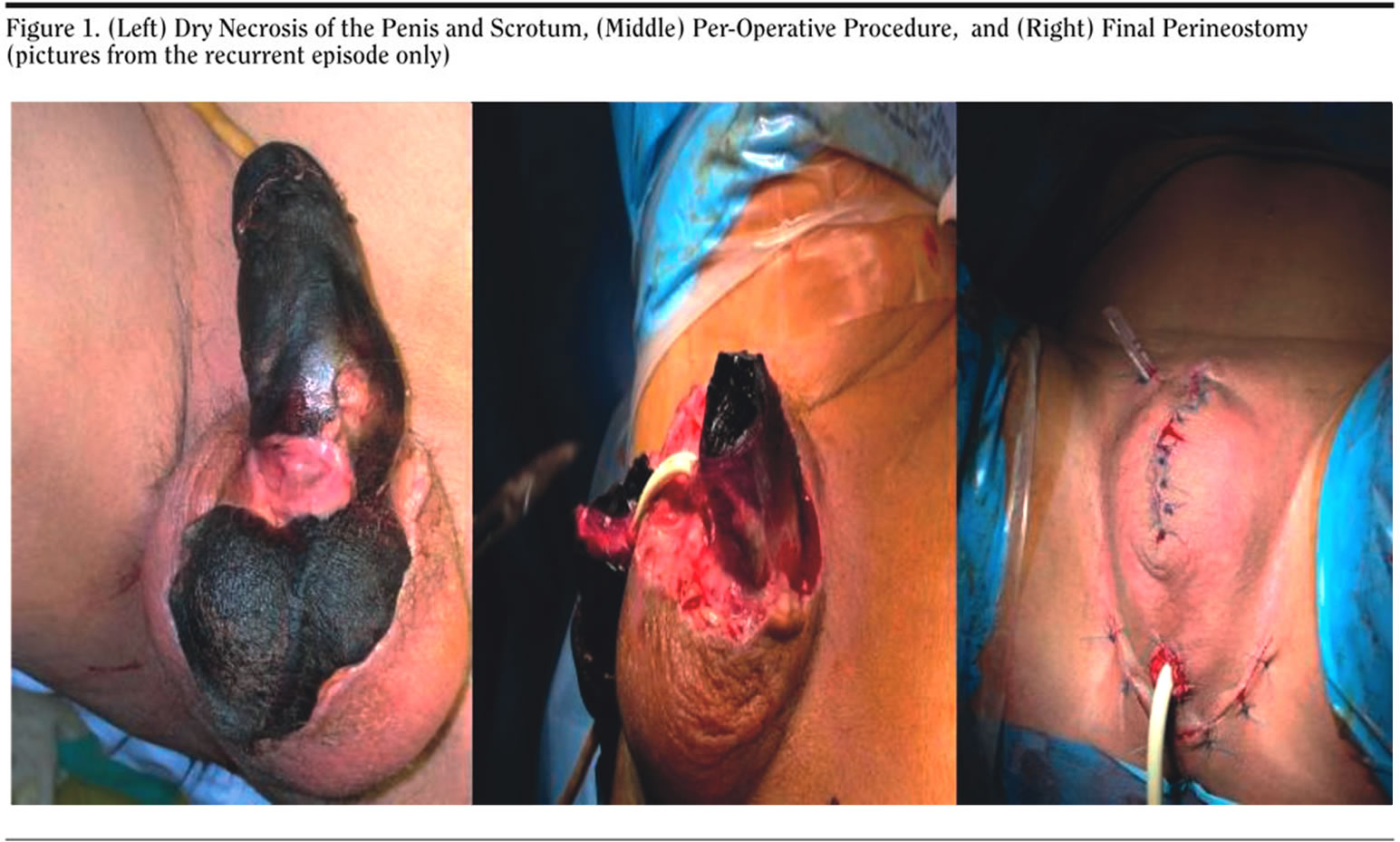<!– function showImage(state) { if (state==’hidden’) { document.getElementById(‘overlay’).style.display=’inline’; document.getElementById(‘instructions’).innerHTML=’Hide image.’; } } else { document.getElementById(‘overlay’).style.display=’none’; document.getElementById(‘instructions’).innerHTML=’Figure 1. Image obscured due to graphic content. View image.’; } } } –>
Penile Amputation After Trazodone-Induced Priapism: A Case Report
To the Editor: Painful persisting penile erection (priapism) is a rare but very serious side effect that can occur with antidepressants in general1-4 and with trazodone in particular.5,6 Trazodone is a very commonly prescribed antidepressant.7,8 Although clear evidence is lacking, trazodone is often administered, in clinical practice, to treat disordered sleep as in insomnia (eg, see Mendelson8).
Case report. Mr A, a 35-year-old white man, was admitted in 2006 to the emergency ward with priapism lasting for about 15 hours. Clinical interview did not reveal previous events of priapism, substance abuse, or genital trauma.
His clinical history contained an episode of a deep vein thrombosis, followed by a pulmonary embolism, at the age of 21 years. He was treated since then with antivitamin K anticoagulant medication (acenocoumarol). The underlying etiology of this thrombotic event had never been determined. Other than priapism, findings of physical examination, blood sample, and toxicologic analyses were within normal limits. Anticoagulant therapy resulted in an international normalized ratio (INR) of 3.8, which was higher than the reference range (0.8-1.2). Screening for psychoactive drugs and urine toxicology was negative. Antidepressants had not been screened. Aspirated blood from the corpus cavernosum was submitted for blood gas testing and was consistent with an ischemic priapism.
After a successful Winter shunting, a complete remission of priapism was obtained and the patient was discharged within 3 days. Unfortunately, the patient did not mention, at first anamnesis, a recent introduction of trazodone in his medical treatment for a complaint of disordered sleep by a psychiatrist. The patient did not show up for a follow-up visit, but instead he was readmitted 10 days later for recurrent priapism lasting for 4 hours.
This time, clinical interview revealed the introduction of trazodone 150 mg/d (at bedtime) by a psychiatrist 3 weeks ago for a sleep disorder complaint. The patient also admitted that he did take 300 mg instead of 150 mg several times during this period. Psychiatric diagnosis given by the treating physician was (1) dyssomnia not otherwise specified on Axis 1 and (2) personality disorder not otherwise specified on Axis 2, according to DSM-IV criteria.
Blood tests revealed no abnormalities with the exception of an INR at 12 (verified on 2 different blood samples). Despite a new shunting, an incision of the corpus cavernous and spongious, and anticoagulant therapy with an INR at 12, the patient had an unfavorable outcome with persistent thrombosis. Forty-eight hours later, a dry necrosis of the glans appeared. After 3 weeks of conservative treatment, amputation of the penis with perineostomy had to be realized (Figure 1).
Figure 1. Image obscured due to graphic content. View image.
Although the present case combined several risk factors with a history of deep venous thrombosis and a genotype investigation that showed a heterozygote mutation R506Q for the Leiden V factor, we cannot explain a thrombosis with an INR at 12 and normal levels of antithrombin III and proteins C and S. Moreover, no episode of priapism occurred prior to the introduction of trazodone in this patient. Prescription of antidepressants and probably of trazodone in particular should be carefully administered and closely monitored in patients with history of coagulopathy or clotting disorders.
References
1. du Toit RM, Millson RC, Heaton JP, et al. Priapism. Can J Psychiatry. 2004;49(12):868-869. PubMed
2. Dent LA, Brown WC, Murney JD. Citalopram-induced priapism. Pharmacotherapy. 2002;22(4):538-541. doi:10.1592/phco.22.7.538.33672 PubMed
3. Bertholon F, Krajewski Y, el Allali A. Adverse effects: priapism caused by paroxetine. Ann Med Psychol (Paris). 1996;154(2):145-146. PubMed
4. Samuel RZ. Priapism associated with venlafaxine use. J Am Acad Child Adolesc Psychiatry. 2000;39(1):16-17. doi:10.1097/00004583-200001000-00010 PubMed
5. Raskin DE. Trazodone and priapism. Am J Psychiatry. 1985;142(1):142-143. PubMed
6. Saenz de Tejada I, Ware JC, Blanco R, et al. Pathophysiology of prolonged penile erection associated with trazodone use. J Urol. 1991;145(1):60-64. PubMed
7. Jayaram G, Rao P. Safety of trazodone as a sleep agent for inpatients. Psychosomatics. 2005;46(4):367-369. doi:10.1176/appi.psy.46.4.367 PubMed
8. Mendelson WB. A review of the evidence for the efficacy and safety of trazodone in insomnia. J Clin Psychiatry. 2005;66(4):469-476. doi:10.4088/JCP.v66n0409 PubMed
Author affiliations: Department of Urology, University Clinics of Brussels, Erasme Hospital (Dr Hoffmann), and Department of Psychiatry, Brugmann University Hospital (Dr D. Neu), Université Libre de Bruxelles, Brussels, Belgium; and Department of General Surgery, Neu Medical Facility, Wadrill, Germany (Dr E. T. Neu).
Potential conflicts of interest: None reported.
Funding/support: None reported.
Published online: April 22, 2010 (doi:10.4088/PCC.09l00816gry).
Prim Care Companion J Clin Psychiatry 2010;12(2):e1-e2
© Copyright 2010 Physicians Postgraduate Press, Inc.





